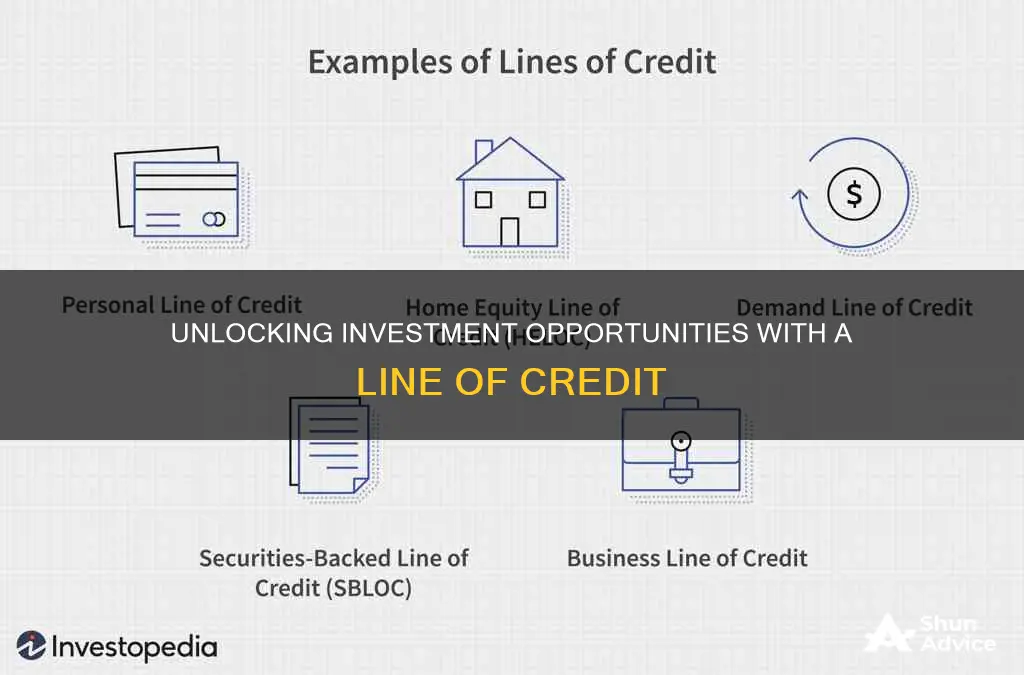
Borrowing to invest is a strategy that can help investors reach their personal and financial goals. It involves taking on debt to secure investments, which may seem counterintuitive, but can potentially lead to lucrative returns if done strategically. One way to borrow funds for investing is through a line of credit, which can provide flexible access to capital with no formal credit application process. However, it's important to carefully consider the risks, such as the potential for investment values to drop and the variable nature of interest rates.
| Characteristics | Values |
|---|---|
| Interest rate | Variable, based on the TD Prime Rate |
| Collateral | Eligible investments |
| Credit access | Reusable as you pay back |
| Repayment | Choose how much to repay |
| Access | TD Access Card, cheques and EasyWeb Online banking |
| Risk | If the market value of pledged securities drops below certain levels, you may be asked to pay down the line of credit or pledge additional securities to maintain it |
What You'll Learn

Pros of a portfolio line of credit
A portfolio line of credit can be a great way to access cash quickly and easily. Here are some pros of a portfolio line of credit:
- No credit checks: Since the loan is directly tied to your brokerage account and your investments serve as collateral, there is no need for a credit check.
- Lower interest rates: The interest rates are typically lower than with other forms of borrowing, such as credit cards or traditional loans, as the loan is secured by your investments. These rates may even be negotiable based on the total amount of assets invested with the firm.
- Flexibility: There is no set repayment schedule, giving you the flexibility to repay the loan on your own terms. You can choose to make recurring payments, pay the minimum amount due, or pay off the full balance without incurring any prepayment or early payment penalties.
- No capital gains tax: By borrowing against your investments without selling them, you can avoid triggering the usual capital gains tax.
- Tax deductions: In some cases, you may be able to write off the interest costs as an investment expense on your taxes, further reducing the overall cost of borrowing.
- Quick access to cash: The money from a portfolio line of credit is usually available immediately or within a short period, providing easy access to funds when you need it.
While a portfolio line of credit offers several advantages, it's important to carefully consider the risks involved before making a decision. It's always a good idea to consult with a financial advisor or expert to understand if this option aligns with your financial goals, risk tolerance, and overall investment strategy.
General Partners: Cash Investment Strategies and Decisions
You may want to see also

Cons of a portfolio line of credit
A portfolio line of credit can be a risky move, especially if you are averse to volatility. Here are some of the cons of a portfolio line of credit:
Risk of Losing More Money Than Invested
The value of your investments, or the underlying collateral, fluctuates with the market. So, in a volatile environment, you could end up owing a lot more than you initially borrowed. If the value of your portfolio falls below a certain threshold, you may have to deposit additional funds or sell a portion of your portfolio to repay some of the loan.
Variable Interest Rates
The interest rate on a portfolio line of credit is not locked, meaning that the rates can go up or down at any time. While having a variable interest rate can be beneficial in low-interest-rate environments, it can be detrimental when interest rates rise.
Risk of Overleveraging
If you take out too much money, you risk becoming "overleveraged" by borrowing too large a percentage of your portfolio's value. Experts advise against borrowing more than 50% to 60% of your total portfolio value.
Margin Call Risk
If your portfolio value declines below a certain threshold, triggering a "margin call," you may be required to deposit additional funds (add more collateral) or sell a portion of your portfolio to repay some of the loan. If you don't act quickly enough, the brokerage may sell your investments without your consent to protect itself.
Limited Ability to Shop for Rates
Because your assets are with one institution, taking out a loan eliminates your ability to shop around for the best rate unless you are willing to leave your current broker.
Using Investing.com's Screener: A Step-by-Step Guide to Stock Screening
You may want to see also

When to use a portfolio line of credit
A portfolio line of credit is a loan that uses the securities in your taxable investment account as collateral. The larger your portfolio, the more money you can borrow.
- When you need quick access to funds: With a portfolio line of credit, you can often get the money you need within a few hours or even immediately. There is no formal credit application process, and the loan can be provided relatively quickly. This makes it a good option when you need immediate access to funds, such as in an emergency situation.
- When you want to diversify your investments: A portfolio line of credit can be used to leverage your current portfolio and diversify your assets. For example, if you have a lot of assets tied up in company stock, you may want to borrow against your portfolio to invest in another asset class. This can help reduce your risk by not having all your investments in one type of security.
- When you want to take advantage of investment opportunities: If you come across an attractive investment opportunity that requires more capital than you currently have available, a portfolio line of credit can provide you with the necessary funds. This can be especially beneficial if you believe the investment opportunity has the potential to generate higher returns than the interest cost of the loan.
- When you want to avoid selling your investments: If you need funds but don't want to sell your current investments, a portfolio line of credit allows you to borrow against your portfolio without liquidating your securities. This can be advantageous if you believe your investments will increase in value over time or if you want to avoid the tax implications of selling.
- When you have a well-diversified portfolio and a high-risk tolerance: Borrowing against your investments carries a higher risk than paying for investments outright with cash. There is a possibility that your investments may decrease in value, and you will still need to repay the loan plus interest. Therefore, it is important to carefully consider your risk tolerance and ensure that you are comfortable with the potential losses before using a portfolio line of credit.
Smart Investment Strategies: Ring Molds Explained
You may want to see also

Alternatives to a portfolio line of credit
If a portfolio line of credit doesn't seem like the right option for you, there are several alternatives to consider. Here are some options:
Home Equity Line of Credit (HELOC)
A HELOC allows you to borrow against the equity in your home. This option offers potentially tax-deductible interest expenses and typically lower interest rates compared to credit cards and personal loans. However, it's important to remember that your home serves as collateral, and if you're unable to make payments, your home could be at risk of foreclosure. The application process for a HELOC can also be time-consuming as it involves a home appraisal and a review of your credit history.
Traditional Loans
You can explore more traditional loan options such as personal loans, car loans, or credit cards. These loans are typically based on your creditworthiness and income and may offer a lump sum of money with fixed monthly installments.
Retirement Account Loan
In some cases, you may be able to access a loan from your 401(k) or 403(b) employer-sponsored retirement account. However, experts generally advise against borrowing from your retirement savings.
Credit Card with Balance Transfer Option
In certain circumstances, a credit card with a balance transfer option could be a viable alternative, especially if it offers a low-cost introductory offer or other perks.
Business Line of Credit
If you're a small business owner, a business or working capital line of credit could be a suitable choice. These loans are designed to fund business-related expenses, such as starting a new venture, expanding operations, or purchasing equipment.
It's important to carefully consider your financial situation, goals, and risk tolerance when evaluating these alternatives. Consulting with a financial professional can provide valuable guidance in making an informed decision.
A Beginner's Guide to Investing with Zerodha
You may want to see also

Borrowing against home equity
Types of Home Equity Loans
There are two main types of home equity loans:
- Home Equity Line of Credit (HELOC): This provides ongoing access to funds and works like a revolving line of credit. It usually has a variable interest rate and allows you to borrow multiple times during a specified borrowing period, typically 10 years. During this time, you can withdraw money up to your credit limit and make repayments as needed. Once the borrowing period ends, you'll repay the remaining balance, usually over 10 to 20 years.
- Home Equity Loan (HELOAN): This resembles a traditional loan, where you borrow a specific amount and receive a one-time cash payout. It usually has a fixed interest rate, and you make regular payments during a fixed repayment period.
Advantages of Borrowing Against Home Equity
- Lower interest rates: Home equity loans and lines of credit often have lower interest rates compared to unsecured loans or credit cards because your home is used as collateral.
- Flexible use of funds: You can use the borrowed funds for various purposes, such as home improvements, debt consolidation, starting a business, or covering emergency expenses.
- Tax benefits: In some cases, the interest paid on home equity loans or lines of credit may be tax-deductible if the funds are used for specific purposes, such as buying, building, or improving your home.
Disadvantages and Risks
However, there are also risks and disadvantages to consider:
- Risk of losing your home: If you fail to make payments or default on the loan, your lender may initiate foreclosure proceedings.
- Variable interest rates: Most HELOCs have variable interest rates, which means your interest costs could increase over time.
- Borrowing costs and fees: Home equity loans and lines of credit may come with additional fees and closing costs.
- Misusing the funds: It's important to use the borrowed funds for purposes that will improve your financial position or provide a return on investment. Avoid using home equity for luxury purchases, discretionary expenses, or everyday expenses.
Eligibility and Requirements
To qualify for a home equity loan or line of credit, you typically need to meet certain requirements:
- Equity in your home: Lenders usually require you to have at least 20% equity in your home.
- Verifiable income history: You'll need to demonstrate a stable and reliable source of income, typically for at least two years.
- Good credit score: A credit score of 600 or higher is generally required for home equity loans.
Important Considerations
Before borrowing against your home equity, carefully consider the following:
- Investment risk: Ensure that the potential returns on your investments outweigh the borrowing costs. Understand the risks involved and make sure the investment aligns with your financial goals and risk tolerance.
- Ability to repay: Assess your financial situation and ensure you can afford the loan payments. Create a long-term financial plan that includes repayment of the loan.
- Impact on your home: Remember that your home is at risk if you're unable to make payments. Consider the potential impact on your housing situation if home values drop or your income becomes inconsistent.
A Guide to Investing in Cash-Flow Websites
You may want to see also
Frequently asked questions
A line of credit is a source of readily available credit that you can use whenever you want, without having to reapply each time you access the funds. As you pay off any credit that you have used, it becomes available again.
You can borrow against your account and generally use the money for whatever purpose you’d like. You’ll pay interest on whatever amount you borrow, but there is no preset repayment schedule, so you can pay the loan back as you like.
A line of credit can give you access to cash, but it also has a high degree of risk. The pros include lower interest rates compared to other forms of borrowing, no credit checks, and the money is usually available immediately. The cons include the risk of the value of your portfolio falling below the minimum maintenance dollar requirement, triggering a margin call.
You can get a line of credit from your financial institution. The interest rate will depend on the kind of loan you get and whether you put up collateral.
Alternatives to a line of credit include a home equity line of credit (HELOC), personal loans, car loans, credit cards, or a loan from your 401(k) or 403(b) employer-sponsored retirement account.







